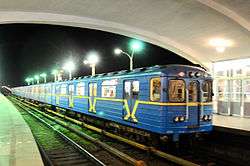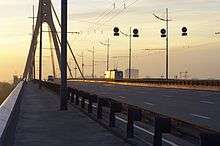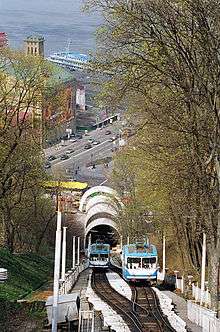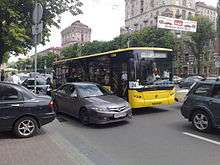Transport in Kiev
Kiev, the capital of Ukraine, has an extensive and rapidly developing transportation infrastructure serving local public needs and facilitating external passenger and cargo traffic.
Local public transport
Public transportation includes the Kiev Metro (underground), buses, trolleybuses, trams and a funicular. The city's first references to public transportation date back to the 1880s, when the city introduced omnibuses and was looking for investment in horse-drawn trams. The most popular means of public transport are the metro and marshrutkas (mini- or midibuses). The Kiev Tramway, the oldest in Eastern Europe, is being replaced by buses and trolleybuses.
Kiev Metro

The publicly owned and operated Kiev Metro system is a fast, convenient and affordable network covering most of the city. The metro is expanding towards the city limits to meet growing demand.
Kyivpastrans
Kyivpastrans operates the Kiev Tramway, some city buses, all trolleybuses and the funicular but not the metro. There are both Kyivpastrans- and privately operated marshrutkas. The Kiev Urban Electric Train is a joint project of Kyivpastrans and Ukrzaliznytsia.
River transport

The previously extensive Kiev River Port riverboat service along the Dnieper River with the Meteor and Raketa hydrofoil ships is no longer available, limiting Kiev's river transport to cargo and tour boats and private pleasure craft.
Road

Kiev is a crossing point for many of Ukraine's main roads. The focal point of the Ukrainian national-road system, Kiev is linked by road to many Ukraine's principal cities. The M05 (linking Kiev with Odessa) and the M06 (linking the city with Chop) have been reconstructed.
Without a grade-separated ring road, Kiev has two urban bypass routes. The Central Ring (Small Bypass Road) comprises a number of interconnecting, high-capacity roads encircling the city centre, with a full circular route on both banks of the Dnieper, and is congested at rush hour. A Big Bypass Road has no river crossings, and is confined to the city's right bank. Despite this, it reduces traffic in the city centre.
Plans exist for a grade-separated ring road around Kiev known as KKAD (ККАД, the Kiev Automotive Ring Road). As of 2011 construction had not begun, although prime minister Mykola Azarov promised that future state budgets would include funding for the ring road[1] (the cost of which was estimated in 2007 at $5-5.5 billion).[2] Construction was planned to begin in 2012.[3]

Many Kiev roads are in bad condition, and maintenance is poor. According to Kyivavtodor (the municipal road corporation), 80 percent of the city's road surfaces have been in use for 15 to 30 years, 1.5 to 3 times more than the standard 12-year lifespan.[4]
All public road transport in Kiev is operated by Kyivpastrans.[5] Some passenger groups (including pensioners) receive free service. The Kiev public-transport system uses a simple tariff system, regardless of distance traveled; ground-transportation tickets must be purchased each time a vehicle is boarded. Discount passes are available for students. Monthly passes, good for 60 rides, are available for combinations of public transportation: metro, bus, trolley and tram. Privately owned minibuses (marshrutkas) cover smaller residential streets with convenient routes. Minibuses take fewer passengers, run faster, stop on demand and have greater availability. Fares and routes of private minibuses are regulated by the city government.

The taxi market in Kiev is poorly regulated (in particular, the fare per kilometer) and there is brisk competition among private companies. Many allow the scheduling of a pickup by telephone. Private citizens with cars provide taxi service on an ad hoc basis, generally by picking up people hailing a cab. Traffic congestion and a lack of parking space are problems for Kiev taxis. Regulations allow parking on sidewalks, which inconveniences pedestrians.
Air
Air passengers arrive in Kiev at one of two airports: the Boryspil Airport (served by international airlines) and the smaller Zhulyany Airport (with domestic flights and limited flights to nearby countries). The international passenger terminal at Boryspil was expanded in 2006, and there is a separate terminal for domestic flights within walking distance. Passengers flying to other countries from Ukraine usually travel through Boryspil, since other airports in the country (such as Odessa, Lviv and Kharkiv) provide limited international connections. The Gostomel cargo airport is in the Kiev northwestern suburb of Hostomel.
Rail

The Kiev Metro is the city’s primary mode of intracity transportation. It was the first rapid transit system in Ukraine, and the third in the USSR (after Moscow and St Petersburg). The system has three lines, with a total length of 66.1 kilometres (41.1 miles), and 51 stations. The metro carries an average of 1.422 million passengers daily,[6] 38 percent of Kiev's public transport. In 2011, the total number of trips exceeded 519 million. The metro has one of the deepest stations in the world: Arsenalna, at 105.5 m or 346 ft.[7]
The funicular climbs the Dnieper's right bank, carrying 10,000–15,000 passengers daily. The city has a long-distance passenger station, six cargo stations and repair facilities.
Construction is underway to convert the Darnytsia Railway Station on the left bank part of the Dnieper into a long-distance passenger hub, which would ease congestion at the central station.[8] The lack of bridges over the river restricts the development of the city’s rail system; only one of two rail bridges is available. A rail-auto bridge is under construction as a part of Darnytsia project.
In 2010 Kiev Urban Electric Train service began, running at four- to ten-minute intervals throughout the day around the city centre and serving many of Kiev's inner suburbs. There are many interchanges with the Kiev Metro.[9]
Suburban Elektrichka trains are run by the publicly owned Ukrainian Railways. More than a dozen elektrichka stops are located in the city.
There are 5 elektrichka routes from the city centre:
- Nizhyn (Northeastern)
- Hrebinka (Southeastern)
- Myronivka (Southern)
- Fastiv (Southwestern)
- Korosten (Western)
See also
References
- ↑ "Азаров дал добро на строительство кольцевой дороги вокруг Киева - Газета "ФАКТЫ и комментарии"". Fakty.ua. Retrieved 2013-03-12.
- ↑ "Вторая кольцевая дорога вокруг Киева обойдется в $5-5,5 млрд. - Последние новости Киева - Однако в направлении окружной дороги уже вся земля выкуплена | СЕГОДНЯ". Segodnya.ua. 2007-06-27. Retrieved 2013-03-12.
- ↑ "Азаров прогнозирует начало строительства второй кольцевой дороги вокруг Киева в 2012 году | Новости Киева". Korrespondent.net. Retrieved 2013-03-12.
- ↑ Kyiv Administration: Roads Are In Poor Technical State Because They Have Reached End Of Their Service Lives And Annual Maintenance Volume Is Low, Ukrainian News Agency (12 June 2009)
- ↑ See also: Kyivpastrans official website. Retrieved 28 July 2006.
- ↑ (Ukrainian) Kyiv General Department of Statistics, 2011
- ↑ (Ukrainian) Official website
- ↑ (Russian) Archunion.com.ua. Retrieved 20 June 2006.
- ↑ "Азаров запустил в Киеве городскую электричку | Экономика | РИА Новости – Украина". Ua.rian.ru. 2012-08-13. Retrieved 2013-03-12.
External links
| Wikimedia Commons has media related to Transport in Kiev. |
